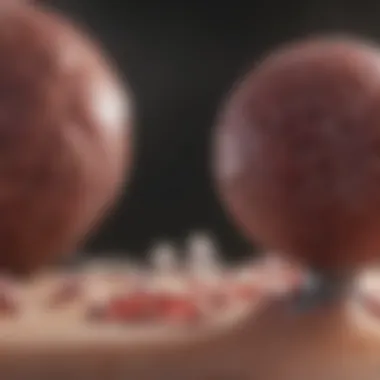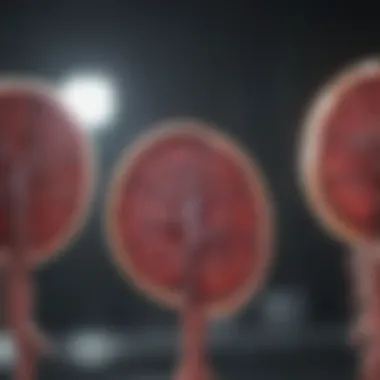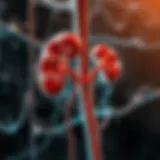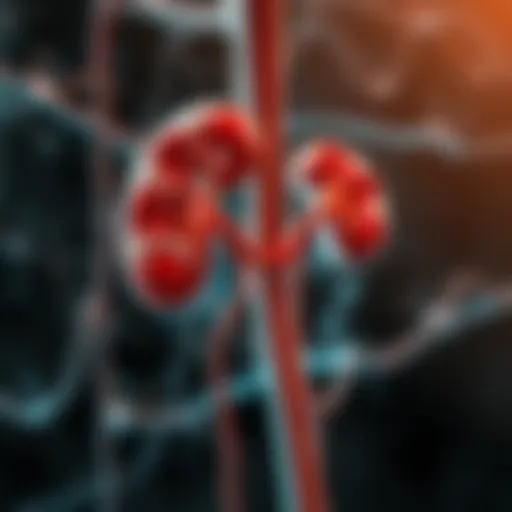Understanding the Allosure Test in Kidney Transplantation


Intro
The advancement of diagnostic tests has revolutionized the field of medicine in many ways. One notable innovation is the Allosure test, particularly significant in the management of kidney transplantation. It provides unprecedented insights into the health of transplanted organs and the recipient's immune response. This article delves into the fundamental aspects of the Allosure test, exploring its methodology, clinical relevance, and its place in patient care.
Overview of Research Topic
Brief Background and Context
Kidney transplantation remains one of the most effective treatments for end-stage renal disease. However, post-transplant complications, especially acute rejection, pose substantial risks to graft survival. Traditional monitoring methods, such as invasive biopsies, have been the standard approach for assessing graft health. The Allosure test offers a non-invasive alternative, analyzing donor-derived cell-free DNA in the recipient’s bloodstream.
Importance in Current Scientific Landscape
In a landscape increasingly focused on personalized medicine, the Allosure test represents a significant leap forward. It not only reduces the need for invasive procedures but also enhances the ability to monitor transplant recipients more effectively. This innovation is crucial, given the complexities of transplant immunology and the need for precise management of immunosuppressive therapy. Through this section, we can see how the Allosure test aligns with the trends of advanced genomic diagnostics.
Methodology
Research Design and Approach
The Allosure test is built upon a robust methodological framework. It employs next-generation sequencing technology to quantify donor cell-free DNA in the recipient's plasma. This process begins with the collection of a blood sample from the recipient, followed by the extraction of DNA. The sequencing results provide a quantifiable measure of the donor's DNA as a proportion of the total cell-free DNA.
Data Collection Techniques
Data collection involves precise laboratory techniques that ensure accuracy and reliability. The primary steps include:
- Blood sample acquisition from the patient.
- Application of specialized kits for DNA extraction and purification.
- Deployment of state-of-the-art sequencing equipment to analyze the DNA.
- Data interpretation through bioinformatics tools to derive clinical conclusions.
Through these techniques, clinicians gain vital insights into the graft's health status, enabling timely interventions.
In summary, the Allosure test is positioned as a pivotal tool in the management of kidney transplantation, marrying innovative technology with clinical necessity. This article will further explore its comparative effectiveness against traditional biopsy methods and bring to light future directions for its integration into routine care.
Prelude to Kidney Transplantation
Kidney transplantation is a pivotal treatment option for individuals suffering from end-stage renal disease. The procedure offers not just an extension of life but also significant improvements in quality of life. It is vital for understanding the complexities surrounding the Allosure test, as this test is strongly linked to the management of transplant patients.
In kidney transplantation, the recipient receives a healthy kidney from a donor. This can be either a living donor or a deceased one. The surgery itself is just one aspect of a long-term process that requires continuous monitoring and management to ensure the success of the transplant. Failure to recognize complications early can lead to severe health consequences, making post-transplant evaluation essential.
The importance of post-transplant monitoring cannot be overstated. It directly influences patient outcomes, influencing long-term survival rates and the health of the graft. Tools such as the Allosure test help clinicians make informed decisions. By examining donor-derived cell-free DNA, this test can provide insights about graft health and whether an acute rejection is occurring. Hence, an understanding of kidney transplantation sets the foundation for appreciating the innovations in transplant diagnostics, including the Allosure test.
In summary, a comprehensive grasp of kidney transplantation and its implications prepares us for a deeper investigation into modern techniques like the Allosure test. The next section delves into the overview of kidney transplants, exploring their significance and contextual framework.
Overview of Kidney Transplant
Kidney transplantation has evolved significantly over the years, marked by advancements in surgical techniques, immunosuppressive therapies, and donor management. A successful transplant involves careful selection of donors and recipients, as well as precise surgical execution. The effectiveness of this treatment modality is largely due to improved medical protocols that enhance graft acceptance and minimize rejection episodes.
The surgery involves the placement of a new kidney into the recipient's body, usually in the lower abdomen. The old, non-functioning kidneys are often left in place unless they cause complications. Post-operative care is crucial whereby regular monitoring is essential to ensure the patient's body is accepting the new organ.
The results of kidney transplantation can vastly improve renal function, alleviate are symptoms of kidney failure, and positively impact the patient's overall health. However, the risk of rejection remains, thus underscoring the need for constant vigilance and evaluation throughout the patient's recovery.
Importance of Post-Transplant Monitoring
Post-transplant monitoring is critical for several reasons. First, it helps in the early detection of potential complications, including acute rejection. Acute rejection is a sudden response of the immune system against the new kidney. Recognizing signs of this condition early on can be life-changing, as it allows for timely intervention.
Second, ongoing monitoring supports long-term graft function. Blood tests, imaging, and the Allosure test are vital components of a comprehensive post-transplant evaluation plan. Regular assessments can inform medical teams about the organ's health status, providing valuable information that guides treatment decisions.
Lastly, continuous follow-up encourages patient engagement in their care. It provides a structured framework for patients to understand their health goals and adhere to their medication regimens. Ultimately, robust post-transplant monitoring facilitates better health outcomes and enhances the longevity of the graft.
"Understanding the importance of post-transplant monitoring is essential for life-long success after receiving a kidney transplant."


Thus, comprehending these aspects paves the way for a detailed exploration of innovative diagnostic tools like the Allosure test in subsequent sections.
The Concept of Donor-Derived Cell-Free DNA
The exploration of donor-derived cell-free DNA is central to modern transplant medicine. This concept enables clinicians to monitor the health of transplanted organs in real-time. Unlike traditional methods that rely on tissue biopsies, analyzing cell-free DNA provides a glimpse into the body's response to the graft. Understanding this topic is crucial because it shifts the focus from invasive procedures to less intrusive evaluations. The implications of cfDNA technology extend beyond diagnostics, offering a potential pathway to personalize treatment decisions for each patient.
Definition and Sources of cfDNA
Donor-derived cell-free DNA refers to fragments of DNA that are found in the blood of transplant recipients. These fragments originate from the transplanted organ. When a kidney is placed in a recipient, some of its cells undergo apoptosis or necrosis, releasing their DNA into the bloodstream. The major sources of cfDNA include:
- Transplanted organ cells: The primary source of cfDNA, as these cells break down post-transplant.
- Host immune response: The recipient's immune system may also contribute to cfDNA as it reacts to foreign material.
- Other biological processes: Non-transplant related factors like infections or tissue damage can influence cfDNA levels.
The detection and quantification of this DNA are done through sensitive laboratory techniques. These processes help determine the proportion of donor-derived cfDNA in relation to the total cfDNA.
Role of cfDNA in Transplantation
In the field of transplantation, cfDNA plays multiple significant roles.
- Non-Invasive Monitoring: The Allosure test can identify potential rejection episodes without needing a surgical biopsy. This is a huge benefit for patient comfort and recovery.
- Early Detection: Detecting elevated levels of donor-derived cfDNA can signal acute rejection at a stage when intervention is crucial for preserving graft function.
- Assessment of Graft Health: Monitoring cfDNA allows for ongoing assessment of transplant organ health. Thus, clinicians can make timely adjustments to immunosuppressive therapy based on precise data.
- Predictive Value: Research suggests that changes in cfDNA levels may correlate with clinical outcomes, which can aid in predicting long-term graft survival.
In summary, donor-derived cell-free DNA represents a revolutionary advancement in transplant diagnostics. The ability to non-invasively gauge organ health directly influences patient management strategies and could potentially lead to improved outcomes in kidney transplantation.
What is the Allosure Test?
The Allosure test represents a significant advancement in the realm of kidney transplantation. It serves as a non-invasive method for monitoring graft health by analyzing donor-derived cell-free DNA (cfDNA) present in the recipient's bloodstream. This innovative approach aligns with the growing need for precision medicine in transplant care. As more transplant recipients face varied graft survival outcomes, understanding the Allosure test becomes crucial for both patients and healthcare providers.
The Allosure test not only aids in detecting potential acute rejection episodes but also offers insights into overall graft function. Its ability to provide timely information allows for proactive management strategies, thereby enhancing patient outcomes. This test stands out among other monitoring methods, emphasizing the shift towards molecular diagnostics in transplantation.
Test Methodology
The methodology of the Allosure test is designed to be efficient and accurate. The test extracts cfDNA from a simple blood sample taken from the recipient. This process involves several key steps:
- Sample Collection: Blood is drawn from the patient, typically in a clinical setting.
- DNA Isolation: The cfDNA is isolated using advanced laboratory techniques.
- Quantitative Analysis: A quantitative polymerase chain reaction (qPCR) is performed to measure levels of donor-derived cfDNA against recipient DNA.
- Data Interpretation: Results are generated, providing a percentage of cfDNA that is donor-derived, which indicates the likelihood of graft health or rejection.
This streamlined process underscores the test's practicality in clinical routines, enabling healthcare providers to act quickly on the results.
Interpretation of Results
Interpreting the results of the Allosure test involves assessing the level of donor-derived cfDNA in relation to the total cfDNA. The key outcomes from the test can be summarized as follows:
- Low Levels of Donor cfDNA: This typically indicates stable graft function and a lower risk of rejection. Monitoring can continue at regular intervals.
- Moderate to High Levels of Donor cfDNA: These results suggest a heightened risk of acute rejection or ongoing graft distress. Additional clinical evaluations may be warranted to ascertain the need for intervention.
Healthcare providers must consider these results within the broader clinical context, including symptoms and other diagnostic indicators. The Allosure test does not replace traditional methods of monitoring but complements them, providing a comprehensive understanding of the patient’s post-transplant status.
"The Allosure test is a game-changer in transplant diagnostics, giving clinicians the ability to foresee complications and tailor interventions effectively."
In summary, the Allosure test is pivotal in kidney transplantation. As it gains traction in clinical settings, its impact on patient management and outcomes is poised to grow, supporting the ongoing evolution of transplant care.
Clinical Significance of the Allosure Test
The Allosure test plays a vital role in the management of kidney transplant recipients. Understanding its clinical significance helps in appreciating how it can enhance patient care. This test not only provides early detection of potential complications but also assists healthcare providers in tailoring their approaches based on individual patient needs. It shifts the focus from traditional methods of monitoring graft health to a more nuanced, DNA-based analysis.
Predicting Acute Rejection
Acute rejection remains a significant concern for kidney transplant recipients. The Allosure test offers a novel mechanism to assess the risk of this complication. By analyzing donor-derived cell-free DNA, healthcare providers can gauge the likelihood of rejection much earlier than typical methods allow. Elevated levels of cfDNA in the recipient's blood can indicate that the recipient's immune system is mounting a response against the transplanted organ. This predictive capability is invaluable because it enables timely intervention.
For instance, if a patient's Allosure test reveals increased cfDNA levels, the transplant team is alerted to initiate further diagnostic measures or adjustments in immunosuppressive therapy. This proactive approach can significantly improve outcomes by preventing irreversible damage to the graft.


Monitoring Graft Health
Monitoring the health of the transplanted kidney is paramount in transplantation care. The Allosure test serves as a non-invasive alternative that provides real-time insights into graft function. Unlike traditional biopsy methods, which can be uncomfortable and carry risks, the Allosure test requires only a blood sample. This makes it more patient-friendly and reduces the burden on the healthcare system.
The data obtained from the Allosure test can be crucial for ongoing assessment. Regular testing allows for a close watch on cfDNA levels, providing a dynamic view of the graft's status. In essence, changes in cfDNA concentrations over time can inform about possible complications long before symptoms manifest. This assists clinicians in making informed decisions regarding immunosuppressive therapy and potential interventions.
"The Allosure test exemplifies the shift towards precision medicine in transplantation, combining innovative technology with patient-centered care."
In summary, the clinical significance of the Allosure test is profound. It not only aids in predicting acute rejection but also enhances the ability to monitor graft health effectively. With its capacity to deliver timely insights, the Allosure test stands as a pivotal advancement in post-transplant care protocols.
Comparative Analysis with Traditional Biopsy Techniques
The growing interest in the Allosure test stems from its potential to reshape the conventional landscape of transplantation diagnostics. This section focuses on the essential elements in comparing the Allosure test with traditional kidney biopsy techniques. Understanding these differences helps illuminate the inherent benefits and limitations of each method, ultimately guiding clinical practice for kidney transplant recipients.
Limitations of Kidney Biopsy
Kidney biopsy has long been considered the gold standard for assessing graft health in transplant patients. However, this method is not without its challenges. First, kidney biopsies are invasive procedures that necessitate the use of needles to extract kidney tissue. This invasiveness can cause complications such as bleeding, pain, or infection. The risk of complications can be a significant deterrent for some patients, particularly when they are already managing the stress of post-transplant recovery.
Moreover, the biopsy provides only a snapshot of the graft's condition at a specific moment. This temporal limitation means that potential issues may be missed, especially if they arise shortly after the procedure. Also, the interpretation of biopsy results can be subjective. Different pathologists may have varying opinions on the same sample, resulting in inconsistencies in diagnosis and management strategies.
Lastly, biopsy samples can frequently yield insufficient material for conclusive analysis, complicating a definitive understanding of graft health. In essence, while effective, traditional biopsy techniques are encumbered by risks and limitations that impact their practical utility in ongoing transplant patient care.
Advantages of the Allosure Test
In contrast to conventional kidney biopsy, the Allosure test offers several notable advantages. Primarily, it is a non-invasive method that analyzes donor-derived cell-free DNA present in the recipient's bloodstream. This blood-based test eliminates the need for needle extraction, greatly reducing the inherent risks associated with biopsies.
One of the most appealing aspects of the Allosure test is its ability to provide real-time insights into graft health. It assesses the presence of transplant-specific cfDNA, offering a dynamic view of graft status. This capability allows for more timely and potentially proactive interventions if the data indicate early signs of acute rejection or other graft-related issues.
Additionally, the Allosure test boasts higher sensitivity for detecting graft injury compared to traditional biopsy methods. This means it can identify subtle changes in graft health that might go undetected in a biopsy. The test also benefits from standardized interpretation, where clear thresholds guide clinicians in decision-making processes.
In summary, while kidney biopsy presents certain challenges that can hinder its effectiveness, the Allosure test emerges as a compelling alternative. Its non-invasive nature and ability to provide continuous monitoring enables a more patient-centered approach to kidney transplantation management.
Overall, integrating the Allosure test into transplant care could significantly enhance patient outcomes by minimizing the risks associated with invasive procedures while maximizing the accuracy of graft health monitoring.
The comparative analysis between these two techniques underscores the importance of evolving diagnostic tools in improving medical practice. With advancements in technology, the promise of Allosure testing demonstrates how genomic innovation can transform routine care for kidney transplant recipients.
Implementation in Clinical Practice
The implementation of the Allosure test in clinical practice is a significant advancement in the management of kidney transplant recipients. This test not only offers a new means of monitoring graft health but also enhances the overall patient care strategy following transplantation. In this section, we will discuss the key guidelines currently employed and how the Allosure test is integrated into existing post-transplant protocols.
Current Usage Guidelines
The utilization of the Allosure test is guided by specific recommendations developed through clinical research and expert panel opinions. Various governing bodies provide these guidelines to ensure the appropriate application of the test. Generally, the test is indicated in the following circumstances:
- Routine Monitoring: The Allosure test is recommended for routine post-transplant monitoring of kidney function. It helps in detecting potential complications early.
- High-Risk Patients: Patients with higher risks of rejection due to various factors, such as previous rejection episodes, may greatly benefit from regular testing.
- Symptomatic Recipients: If a transplant recipient exhibits symptoms suggesting acute rejection, the Allosure test can quickly assess donor-derived cfDNA in the bloodstream, offering immediate insight into the graft's condition.
The adoption of these guidelines allows healthcare professionals to make informed decisions about patient management, facilitating timely interventions when necessary.
Integration into Post-Transplant Protocols
Integrating the Allosure test into post-transplant protocols represents a shift in how kidney care is approached. Clinicians are now encouraged to incorporate it as a standard part of the post-transplant monitoring routine. This integration can improve patient outcomes in several ways:
- Enhancing Graft Monitoring: The test provides a non-invasive means to evaluate graft health without the need for painful biopsies. This boosts patient comfort and compliance.
- Biomarker Utilization: Allosure serves as a potential biomarker for identifying rejection early. This can lead to prompt therapeutic interventions, ultimately preserving kidney function.
- Multidisciplinary Approach: The results of the Allosure test can inform discussions among nephrologists, transplant surgeons, and nurse practitioners, fostering a collaborative environment in patient care.
While integration may pose initial challenges, such as training healthcare providers and adjusting existing workflows, the long-term benefits for both patients and healthcare systems are significant.
Ultimately, the incorporation of the Allosure test into patient management protocols underscores a move towards more personalized and nuanced transplant care.


Challenges and Limitations
The Allosure test presents a transformative approach in monitoring kidney transplant health, yet it faces several challenges and limitations that must be addressed. Understanding these issues is crucial for further integration into clinical practice and optimizing patient outcomes. Awareness of both technical and financial obstacles will allow practitioners and stakeholders to make informed decisions regarding the application of this test.
Technical Limitations of Allosure Testing
While the Allosure test has benefits, there are technical limitations that can impact its reliability and accuracy. One of the primary concerns is the sensitivity and specificity of donor-derived cell-free DNA detection. Factors such as the quality of blood samples and the timing of sampling can affect the concentration of cfDNA detected. Furthermore, variations in individual metabolism between patients can lead to differing baseline levels of cfDNA, complicating the interpretation of results.
Another significant technical limitation relates to the current technology used for testing. The methodologies employed may not capture all relevant mutations or changes in graft DNA, thus producing results that might not fully reflect the status of the transplant. Precision in genomic medicine is paramount, and any oversight in these technical aspects can lead to misinterpretations of graft health, ultimately affecting clinical decisions.
Cost and Accessibility Issues
The incorporation of the Allosure test into standard transplant protocols also raises concerns regarding costs and accessibility. Many healthcare systems are under considerable financial strain, and the introduction of new diagnostic tools can lead to increased expenditure. This raises questions on whether the benefits of the Allosure test justify its costs, especially when traditional methods like biopsies have been routine practices for years.
Additionally, accessibility can be a significant barrier to the broader utilization of the Allosure test. Availability may be limited in rural or under-resourced medical facilities, which can hinder equitable healthcare access among transplant recipients. Patients in these areas may not receive timely monitoring, leading to disparities in outcomes.
The interplay between these technical challenges and cost implications creates a complex landscape that necessitates detailed evaluation and strategic planning to truly realize the full potential of the Allosure test in kidney transplantation.
Future Directions in Kidney Transplant Diagnostics
The exploration of future directions in kidney transplant diagnostics is crucial for improving patient outcomes and enhancing the overall effectiveness of post-transplant care. As the field of transplantation continues to evolve, promising advancements in genomic technologies are at the forefront. These developments hold significant potential to transform the diagnostic landscape, particularly for tests like Allosure, which analyzes donor-derived cell-free DNA.
The integration of cutting-edge genomic tools can offer deeper insights into transplant biology and graft health. This information can lead to more accurate predictions of acute rejection and better risk stratification among kidney transplant recipients. Through advancements in these technologies, clinicians can potentially achieve a more personalized approach to patient management, aiming not just for survival but for quality of life and long-term graft function.
Advancements in Genomic Technologies
Genomic technologies are rapidly advancing, providing new methodologies to assess organ grafts and recipient health. Next-generation sequencing (NGS) has emerged as a powerful method, enabling detailed analysis of cell-free DNA in blood samples. This technique allows for the identification of genetic material specific to the donor, contributing to improved monitoring of graft health.
With NGS, clinicians can quantitatively evaluate cfDNA levels, correlating them with graft status. For instance, heightened levels of donor-derived cfDNA might indicate graft injury or rejection. This real-time assessment can guide timely interventions and treatment adjustments, theoretically resulting in better patient outcomes.
Moreover, these advancements facilitate the development of novel biomarkers that could serve as early warning signals for complications. As researchers continue to refine these technologies, the potential for incorporating machine learning algorithms could enhance predictive accuracy, allowing for even more precise risk assessments tailored to individual patients.
Personalized Medicine in Transplantation
Personalized medicine represents a pivotal shift in how transplant care is delivered. By leveraging genomic data from tests like Allosure, healthcare providers can transition from a one-size-fits-all approach to a more individualized treatment plan. This concept emphasizes treating patients based on their unique genetic profiles, which can influence their response to medications and likelihood of rejection.
For instance, through analyzing cfDNA, physicians may determine which patients are at high risk for rejection, allowing them to adjust immunosuppressive regimens accordingly. This targeted approach not only aims to improve graft survival rates but also seeks to minimize the adverse effects associated with long-term immunosuppression, such as infections or malignancies.
Additionally, embracing personalized medicine could transform patient engagement in their own care. Providing patients with tailored information about their specific risks and treatment options fosters a collaborative relationship between physician and patient, ultimately enhancing adherence to prescribed therapies.
The future of kidney transplantation is promising, with emerging genomic technologies and personalized approaches poised to revolutionize diagnostics and treatment strategies. These advancements signify a shift towards more effective and considerate care for transplant recipients, ensuring that their individual needs and risks are carefully addressed.
"The integration of genomic technologies into transplant diagnostics signifies a move towards more effective healthcare tailored to individual patient needs."
*
Epilogue
The conclusion of an article serves as a vital element that encapsulates the core message and insights shared throughout. In the context of this article, the conclusion underscores the significance of the Allosure test as a transformative tool in the realm of kidney transplantation. It is essential to recognize that as the medical community advances, tools like the Allosure test are becoming increasingly indispensable. This diagnostic method not only offers a less invasive alternative to traditional biopsy techniques but also allows for the continuous monitoring of graft health, which is crucial for improving patient outcomes.
Summary of Key Findings
The Allosure test analyzes donor-derived cell-free DNA to provide critical insights into the state of a transplanted kidney. Key findings presented in this article include:
- Enhanced Graft Monitoring: The ability to track the health of the transplant through blood tests represents a significant shift in post-transplant care.
- Acute Rejection Prediction: Early detection of potential rejection episodes can be achieved through the results of the Allosure test, enabling timely and potentially life-saving interventions.
- Comparison to Biopsy: This test stands out when compared to traditional biopsy methods by minimizing risks associated with invasive procedures.
By synthesizing these findings, it is clear that the Allosure test plays a crucial role in reshaping transplant management paradigms.
Implications for Future Research
The future of kidney transplantation diagnostics appears promising, with ongoing research expanding the horizons of genomic applications. The implications of findings related to the Allosure test highlight several key avenues for exploration:
- Advancements in Genomic Technologies: Continued enhancement of genomic methodologies may allow for more precise and individualized assessments of transplant health.
- Personalized Medicine: As the medical field moves toward individualized treatments, integrating tests like Allosure could lead to more tailored post-transplant care, improving overall patient satisfaction and outcomes.
- Longitudinal Studies: Conducting extensive longitudinal studies will help determine long-term effects and viability of using the Allosure test as a standard practice.



